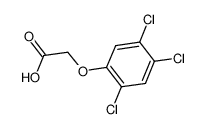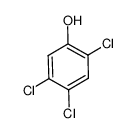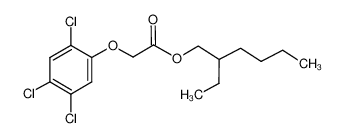| Product name | (2,4,5-trichlorophenoxy)acetic acid |
|---|
| Product number | - |
|---|---|
| Other names | 2,4,5-trichlorophenoxy-acetic acid |
| Identified uses | For industry use only. |
|---|---|
| Uses advised against | no data available |
| Company | MOLBASE (Shanghai) Biotechnology Co., Ltd. |
|---|---|
| Address | Floor 4 & 5, Building 12, No. 1001 North Qinzhou Road, Xuhui District, Shanghai, China |
| Telephone | +86(21)64956998 |
| Fax | +86(21)54365166 |
| Emergency phone number | +86-400-6021-666 |
|---|---|
| Service hours | Monday to Friday, 9am-5pm (Standard time zone: UTC/GMT +8 hours). |
Acute toxicity - Oral, Category 4
Skin irritation, Category 2
Eye irritation, Category 2
Specific target organ toxicity – single exposure, Category 3
Hazardous to the aquatic environment, short-term (Acute) - Category Acute 1
Hazardous to the aquatic environment, long-term (Chronic) - Category Chronic 1
2.2 GHS label elements, including precautionary statements| Pictogram(s) |   |
|---|---|
| Signal word | Warning |
| Hazard statement(s) | H302 Harmful if swallowed H315 Causes skin irritation H319 Causes serious eye irritation H335 May cause respiratory irritation H410 Very toxic to aquatic life with long lasting effects |
| Precautionary statement(s) | |
| Prevention | P264 Wash ... thoroughly after handling. P270 Do not eat, drink or smoke when using this product. P280 Wear protective gloves/protective clothing/eye protection/face protection. P261 Avoid breathing dust/fume/gas/mist/vapours/spray. P271 Use only outdoors or in a well-ventilated area. P273 Avoid release to the environment. |
| Response | P301+P312 IF SWALLOWED: Call a POISON CENTER/doctor/…if you feel unwell. P330 Rinse mouth. P302+P352 IF ON SKIN: Wash with plenty of water/... P321 Specific treatment (see ... on this label). P332+P313 If skin irritation occurs: Get medical advice/attention. P362+P364 Take off contaminated clothing and wash it before reuse. P305+P351+P338 IF IN EYES: Rinse cautiously with water for several minutes. Remove contact lenses, if present and easy to do. Continue rinsing. P337+P313 If eye irritation persists: Get medical advice/attention. P304+P340 IF INHALED: Remove person to fresh air and keep comfortable for breathing. P312 Call a POISON CENTER/doctor/…if you feel unwell. P391 Collect spillage. |
| Storage | P403+P233 Store in a well-ventilated place. Keep container tightly closed. P405 Store locked up. |
| Disposal | P501 Dispose of contents/container to ... |
none
3.Composition/information on ingredients 3.1 Substances| Chemical name | Common names and synonyms | CAS number | EC number | Concentration |
|---|---|---|---|---|
| (2,4,5-trichlorophenoxy)acetic acid | (2,4,5-trichlorophenoxy)acetic acid | 93-76-5 | none | 100% |
Consult a physician. Show this safety data sheet to the doctor in attendance.
If inhaledFresh air, rest.
In case of skin contactRemove contaminated clothes. Rinse and then wash skin with water and soap.
In case of eye contactFirst rinse with plenty of water for several minutes (remove contact lenses if easily possible), then refer for medical attention.
If swallowedRinse mouth. Give a slurry of activated charcoal in water to drink. Refer for medical attention .
4.2 Most important symptoms/effects, acute and delayedOverexposure to dust by inhalation or ingestion may cause fatigue, nausea, vomiting, lowered blood pressure, convulsions, coma. Dust may irritate eyes and skin. (USCG, 1999)
4.3 Indication of immediate medical attention and special treatment needed, if necessary Absorption, Distribution and Excretion2,4,5-T given orally to ... volunteers in doses of 100-150 mg was readily absorbed and gradually eliminated from blood plasma, showing first-order elimination rate; more than 80% of dose was excreted in urine in intact form within 72 hr. Daily urinary excretion ... in exposed workers was found to range from 0.5-3.6 mg/day in 11/21 samples.
5.Fire-fighting measures 5.1 Extinguishing media Suitable extinguishing media/Wear/ self-contained breathing apparatus with a full facepiece operated in pressure-demand or other positive pressure mode /when fighting fire/.
5.2 Specific hazards arising from the chemicalSpecial Hazards of Combustion Products: Toxic hydrogen chloride and phosgene gases may be formed. (USCG, 1999)
5.3 Special protective actions for fire-fightersWear self-contained breathing apparatus for firefighting if necessary.
6.Accidental release measures 6.1 Personal precautions, protective equipment and emergency proceduresUse personal protective equipment. Avoid dust formation. Avoid breathing vapours, mist or gas. Ensure adequate ventilation. Evacuate personnel to safe areas. Avoid breathing dust. For personal protection see section 8.
6.2 Environmental precautionsPersonal protection: particulate filter respirator adapted to the airborne concentration of the substance. Do NOT let this chemical enter the environment. Sweep spilled substance into covered containers. If appropriate, moisten first to prevent dusting. Carefully collect remainder. Then store and dispose of according to local regulations.
6.3 Methods and materials for containment and cleaning up1. VENTILATE AREA OF SPILL. 2. COLLECT SPILLED MATERIAL IN THE MOST CONVENIENT AND SAFE MANNER AND DEPOSIT IN SEALED CONTAINERS FOR RECLAMATION, OR FOR DISPOSAL IN A SECURED SANITARY LANDFILL. LIQUID CONTAINING 2,4,5-T SHOULD BE ABSORBED IN VERMICULITE, DRY SAND, EARTH, OR A SIMILAR MATERIAL.
7.Handling and storage 7.1 Precautions for safe handlingAvoid contact with skin and eyes. Avoid formation of dust and aerosols. Avoid exposure - obtain special instructions before use.Provide appropriate exhaust ventilation at places where dust is formed. For precautions see section 2.2.
7.2 Conditions for safe storage, including any incompatibilitiesProvision to contain effluent from fire extinguishing. Separated from food and feedstuffs. Store in an area without drain or sewer access.DO NOT STORE NEAR OTHER AGROCHEMICALS OR SEEDS. DO NOT STORE IN FREEZING TEMPERATURES.
8.Exposure controls/personal protection 8.1 Control parameters Occupational Exposure limit valuesRecommended Exposure Limit: 10 Hr Time-Weighted Avg: 10 mg/cu m.
Biological limit valuesno data available
8.2 Appropriate engineering controlsHandle in accordance with good industrial hygiene and safety practice. Wash hands before breaks and at the end of workday.
8.3 Individual protection measures, such as personal protective equipment (PPE) Eye/face protectionSafety glasses with side-shields conforming to EN166. Use equipment for eye protection tested and approved under appropriate government standards such as NIOSH (US) or EN 166(EU).
Skin protectionWear impervious clothing. The type of protective equipment must be selected according to the concentration and amount of the dangerous substance at the specific workplace. Handle with gloves. Gloves must be inspected prior to use. Use proper glove removal technique(without touching glove's outer surface) to avoid skin contact with this product. Dispose of contaminated gloves after use in accordance with applicable laws and good laboratory practices. Wash and dry hands. The selected protective gloves have to satisfy the specifications of EU Directive 89/686/EEC and the standard EN 374 derived from it.
Respiratory protectionWear dust mask when handling large quantities.
Thermal hazardsno data available
9.Physical and chemical properties| Physical state | Colorless to tan, odorless, crystalline solid. |
|---|---|
| Colour | WHITE SOLID |
| Odour | Odorless |
| Melting point/ freezing point | 154-158ºC |
| Boiling point or initial boiling point and boiling range | 376.3ºC |
| Flammability | Combustible Solid, but burns with difficulty.Combustible under specific conditions. Liquid formulations containing organic solvents may be flammable. Gives off irritating or toxic fumes (or gases) in a fire. |
| Lower and upper explosion limit / flammability limit | no data available |
| Flash point | 181.4ºC |
| Auto-ignition temperature | no data available |
| Decomposition temperature | no data available |
| pH | no data available |
| Kinematic viscosity | no data available |
| Solubility | less than 0.1 mg/mL at 21°C |
| Partition coefficient n-octanol/water (log value) | log Kow= 4 |
| Vapour pressure | 0 mm Hg at 20°C approximately |
| Density and/or relative density | 1.592 |
| Relative vapour density | no data available |
| Particle characteristics | no data available |
no data available
10.2 Chemical stabilitySTABLE @ ITS MELTING-POINT
10.3 Possibility of hazardous reactionsMaterial does not burn or burns with difficulty.2,4,5-TRICHLOROPHENOXYACETIC ACID is a weak acid. Reacts with organic and inorganic bases to form water-soluble salts and with alcohols to form esters. Incompatible with strong oxidizing agents and strong bases. Can corrode metals, especially if moist. May harm painted surfaces .
10.4 Conditions to avoidno data available
10.5 Incompatible materialsSTABILITY: This chemical is stable under normal laboratory conditions. It is stable in aqueous solution at pH 5-9. Solutions of this chemical in water, DMSO, 95% ethanol or acetone should be stable for 24 hours under normal laboratory conditions.REACTIVITY: This chemical forms water-soluble salts with alkali metals and amines. It reacts with organic and inorganic bases to form salts and with alcohols to form esters. It is incompatible with strong oxidizing agents and strong bases. It can be corrosive to common metals. It may be deleterious to painted surfaces. Precipitation occurs with hard water in the absence of sequestering agents.
10.6 Hazardous decomposition productsToxic gases and vapors /which include/: hydrogen chloride and carbon monoxide.
11.Toxicological information Acute toxicity- Oral: LD50 Mouse oral 389 mg/kg
- Inhalation: no data available
- Dermal: LD50 Rat percutaneous > 5000 mg/kg
no data available
Serious eye damage/irritationno data available
Respiratory or skin sensitizationno data available
Germ cell mutagenicityno data available
CarcinogenicityClassification of carcinogenicity: 1) evidence in humans: limited; Overall summary evaluation of carcinogenic risk to humans is Group 2B: The agent is possibly carcinogenic to humans. /Chlorophenoxy herbicides; From table/
Reproductive toxicityno data available
STOT-single exposureno data available
STOT-repeated exposureno data available
Aspiration hazardno data available
12.Ecological information 12.1 Toxicity- Toxicity to fish: LC50 Lepomis macrochirus (bluegill) 0.50 mg/l/48 hr /Conditions of bioassay not specified
- Toxicity to daphnia and other aquatic invertebrates: no data available
- Toxicity to algae: no data available
- Toxicity to microorganisms: no data available
Aerobic degradation of 10 ug 2,4,5-T of soil was 5-35% in unsterilized tropical clay and silty clay soils and <1% in sterilized soils after 4 months incubation(1). In Vietnamese soils, 64-69% aerobic degradation of 1 ppm 2,4,5-T occurred in 49 days, 74-96% aerobic degradation of 15 ppm 2,4,5-T occurred in 168 days and no degradation was observed in sterilized soils(2). The primary degradation product of 2,4,5-T in aqueous and soil systems is 2,4,5-trichlorophenol(3). Aerobic metabolism of 2,4,5-T leads to formation of 2,4,5-trichlorophenol and 3,5-dichlorocatechol which may further degrade to 4-chlorocatechol or cis,cis-2,4-dichloromuconic acid, 2-chloro-4-carboxy-methylene-but-2-enolide, chlorosuccinic acid and succinic acid(2). Degradation under anaerobic conditions has led to the formation of di- and mono-chlorophenols and 2,5-dichlorophenoxyacetic acid(4,5). Anaerobic degradation occurs much more slowly than aerobic degradation(6).
12.3 Bioaccumulative potentialThe bioconcentration factor (BCF) of 2,4,5-T in static ecosystem tests has been measured to be 23-25 in fish(1,2). Under flowing water conditions its estimated BCF in fish is 43(1). Based on these BCF values, bioconcentration in aquatic organisms should not be significant.
12.4 Mobility in soilMeasured soil adsorption coefficient (Koc) values for 2,4,5-T in various soils are as follows: 86-sand, 186-whole soil, 204-fines, 205-coarse clay, 206-coarse silt and 280-medium silt(1). Measured soil TLC Rf values are as follows: 0.17-muck, 0.48-clay, 0.54-silt clay loam and 0.73-0.89-sandy loam(2). These Koc and Rf values indicate that 2,4,5-T mobility in soil should vary from highly mobile in sandy soil to moderately mobile in clay and silt loams to slightly mobile in muck (3,4). Humic acids found in almost all water and soil systems have been shown to strongly adsorb 2,4,5-T from solution(5), and the tendency of 2,4,5-T to adsorb to soil has been observed to increase with increasing organic content in soil(6). When 11.2 kg/ha 2,4,5-T was applied to a large field lysimeter, 96-99% of the undegraded herbicide remained 0-10 cm deep and 0.33-3.7% remained between 10 to 30 cm deep after 2-3 winters(7). Up to 8 weeks following application of 1 g/cu m 2,4,5-T, 86-98% of the undegraded 2,4,5-T applied to arable land remained within the top 30 cm of the soil layer and 84-100% remained within the top 10 cm of forest soil(8).
12.5 Other adverse effectsno data available
13.Disposal considerations 13.1 Disposal methods ProductThe material can be disposed of by removal to a licensed chemical destruction plant or by controlled incineration with flue gas scrubbing. Do not contaminate water, foodstuffs, feed or seed by storage or disposal. Do not discharge to sewer systems.
Contaminated packagingContainers can be triply rinsed (or equivalent) and offered for recycling or reconditioning. Alternatively, the packaging can be punctured to make it unusable for other purposes and then be disposed of in a sanitary landfill. Controlled incineration with flue gas scrubbing is possible for combustible packaging materials.
14.Transport information 14.1 UN Number| ADR/RID: UN2811 | IMDG: UN2811 | IATA: UN2811 |
| ADR/RID: TOXIC SOLID, ORGANIC, N.O.S. |
| IMDG: TOXIC SOLID, ORGANIC, N.O.S. |
| IATA: TOXIC SOLID, ORGANIC, N.O.S. |
| ADR/RID: 6.1 | IMDG: 6.1 | IATA: 6.1 |
| ADR/RID: III | IMDG: III | IATA: III |
| ADR/RID: yes | IMDG: yes | IATA: yes |
no data available
14.7 Transport in bulk according to Annex II of MARPOL 73/78 and the IBC Codeno data available
15.Regulatory information 15.1 Safety, health and environmental regulations specific for the product in question| Chemical name | Common names and synonyms | CAS number | EC number |
|---|---|---|---|
| (2,4,5-trichlorophenoxy)acetic acid | (2,4,5-trichlorophenoxy)acetic acid | 93-76-5 | none |
| European Inventory of Existing Commercial Chemical Substances (EINECS) | Listed. | ||
| EC Inventory | Listed. | ||
| United States Toxic Substances Control Act (TSCA) Inventory | Listed. | ||
| China Catalog of Hazardous chemicals 2015 | Listed. | ||
| New Zealand Inventory of Chemicals (NZIoC) | Listed. | ||
| Philippines Inventory of Chemicals and Chemical Substances (PICCS) | Not Listed. | ||
| Vietnam National Chemical Inventory | Not Listed. | ||
| Chinese Chemical Inventory of Existing Chemical Substances (China IECSC) | Not Listed. | ||
| Creation Date | Aug 14, 2017 |
|---|---|
| Revision Date | Aug 14, 2017 |
- CAS: Chemical Abstracts Service
- ADR: European Agreement concerning the International Carriage of Dangerous Goods by Road
- RID: Regulation concerning the International Carriage of Dangerous Goods by Rail
- IMDG: International Maritime Dangerous Goods
- IATA: International Air Transportation Association
- TWA: Time Weighted Average
- STEL: Short term exposure limit
- LC50: Lethal Concentration 50%
- LD50: Lethal Dose 50%
- EC50: Effective Concentration 50%
- IPCS - The International Chemical Safety Cards (ICSC), website: http://www.ilo.org/dyn/icsc/showcard.home
- HSDB - Hazardous Substances Data Bank, website: https://toxnet.nlm.nih.gov/newtoxnet/hsdb.htm
- IARC - International Agency for Research on Cancer, website: http://www.iarc.fr/
- eChemPortal - The Global Portal to Information on Chemical Substances by OECD, website: http://www.echemportal.org/echemportal/index?pageID=0&request_locale=en
- CAMEO Chemicals, website: http://cameochemicals.noaa.gov/search/simple
- ChemIDplus, website: http://chem.sis.nlm.nih.gov/chemidplus/chemidlite.jsp
- ERG - Emergency Response Guidebook by U.S. Department of Transportation, website: http://www.phmsa.dot.gov/hazmat/library/erg
- Germany GESTIS-database on hazard substance, website: http://www.dguv.de/ifa/gestis/gestis-stoffdatenbank/index-2.jsp
- ECHA - European Chemicals Agency, website: https://echa.europa.eu/





























